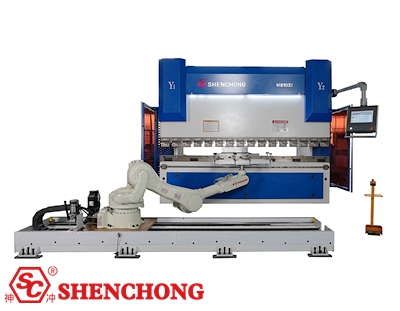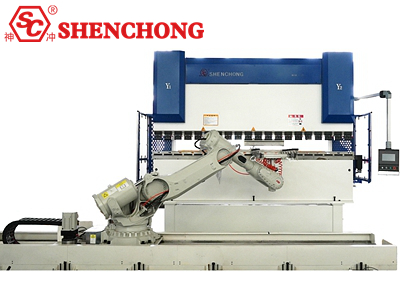

External axis refers to the axis added to the robot body for work purposes, after removing the axis.
For example:
The intrinsic axis of the SCARA robot is 4 axes, so if the external axis of an SCARA is the 5th axis, 6th axis, etc. The external axes of the six axis ARTIC robot are the 7th and 8th axes.

Robotic Press Brake Bending Machine
Install the robot on the slide rail and control the ground slide through external axis function to achieve long-distance movement of the robot. It can achieve large-scale and multi workstation work.
For example, in the machine tool industry, one robotic arm can pick and place workpieces on multiple machine tools, as well as in the welding industry, large-scale welding and cutting.
Compared with the slide rail, the turnover table is independent of the robot body. Through the function of the external shaft, it can be controlled to turn to a specific angle, which is more beneficial for the mechanical arm to process a certain surface of the workpiece.
Mainly used in welding, cutting, spraying, heat treatment and so on. For example, in the spraying industry, the upper and lower surfaces of the workpiece are sprayed by turning the turning table 180 degrees.
Using the function of external shaft to control more kinds of external servo equipment such as servo welding gun, so as to realize more functions of mechanical arm.
For example, in the punching industry, a linear axis is added at the end of the articulated robot, and the rapid movement of the linear axis is controlled by the external axis, thus greatly improving the efficiency of the punching machine.
Robot external axis is widely used, however, do you know which industries it is mainly used in?
Here is a brief introduction for you:
1) Spraying industry (spraying or cleaning containers, automobiles, airplanes and high-speed rail wagons): fully enclosed overhead rail is applicable.
2) Welding industry (spot welding, arc welding): both sky rail and ground rail are applicable.
3) Polishing industry
4) Packaging and palletizing industry
5) Handling robots
6) Intelligent storage of three-dimensional warehouse (multi-station): suitable for supporting ground rail and truss.
7) Testing, inspection, measurement, and scanning industry.
8) Mechanical processing industry (such as multi-machine CNC machining centers connected to online and unloading).
9) Multiple dedicated machines for loading and unloading materials (such as wire winding machines, film winding machines, etc.).
10) Packaging and transportation of products in industrial production.
Robot external shaft technology is an important part of robot technology. Its development can be traced back to the early 20th century. With the continuous progress of computer technology and control technology, the robot external robot technology has also been continuously improved and developed. At present, robot external shaft technology has been widely used in industrial production, medical care, military security and other fields.
The application of robot external shaft technology is more and more extensive, and its main features are mainly shown in the following aspects:
The robot external shaft technology can be used for various industrial production tasks, such as assembly, handling, welding and spraying.
2) Medical care:
Robot external shaft technology can be used in surgery, rehabilitation, nursing and other aspects to improve the efficiency and quality of medical care.
3) Military security:
Robot external axis technology can be used in the field of military security, such as reconnaissance, search and rescue, attack, etc.
4) Other fields:
Robot external shaft technology can also be applied to education, entertainment, transportation and other fields.
In the future, the external axis technology of robots will continue to develop, mainly manifested in the following aspects:
1) Intelligence
The external axis of the robot will be more intelligent, able to better adapt to different working environments and task requirements.
2) Multifunctionality
The robot external axis will have more functions and be able to complete more tasks.
3) Flexibility
The external axis of the robot will be more flexible and able to better adapt to different work scenarios.
4) Safety
The external shaft of the robot will be safer and more reliable, which can better ensure the safety of personnel and equipment.